This is a library for a generation that understands knowledge, values and ethics are the basis for the development of a more inclusive society
Teresa e Alexandre Soares dos Santos
This is a library for a generation that understands knowledge, values and ethics are the basis for the development of a more inclusive society
Teresa e Alexandre Soares dos Santos
Get the most out of Teresa e Alexandre Soares dos Santos Library. Navigate our library's book collection, subscribed databases and other useful links.
Explore our guidelines and insights on how to find valuable information for your research needs.
By Thiago Cunha
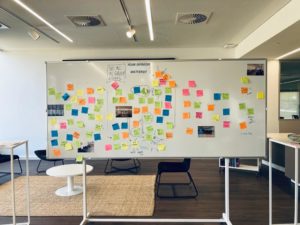
In the first week of June 2022, users who visited the library found a large whiteboard in the informal area, a sharing mural that captured the attention of everyone who somehow passed through our space these days.
We asked for opinions and offered candy, you contributed with several post-its, with very meaningful (and fun) shares about your experience at the library and some of the points we can improve.
The best focus place, ideal to study, but also for the very important breaks of an academic day (with naps in the puffs if possible) were just some of the comments received. It is very significant to receive so much feedback that considers the library as a 2nd home or a safe space. This is a part of what we want as a space.
But it’s not all roses, and in a very objective way, you shared with us some points of improvement that can contribute even more to a better experience when using our services.
We listened, reflected, and decided on some changes to meet your expectations:
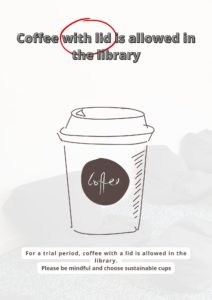
> “We would like to drink coffee in here” – It is a hot topic in all libraries. Food and drinks are often the cause of accidents, and to avoid damage to electronic material, destroyed books and furniture with stains for life, they are not allowed inside library spaces. Based on your requests, for a trial period, coffee with a lid is allowed in the library. Please be mindful and choose sustainable cups
>“AC please” – There were many requests related to the temperature of the library. Effectively, we identified that in periods of greater occupancy the temperature felt on the second floor is very different from that felt on the first floor. The problem is identified and we are working with Facilities to resolve this issue in the short term.
> “Booking is too complicated”– To make the process more agile, we decided to simplify the booking form so that it is not necessary to enter so much information. The rest of the booking and check-in process remains unchanged and we remind you that it is essential to ensure your study space in the library.
“Water dispenser” – We get a lot of post-its asking for water dispensers in the library. The library floor is not the most suitable for contact with water and the points where it would be possible to install a dispenser are not indicated for this purpose. In this case, to proceed with the refill, you must go to the nearest dispensers located in the food court.
Thank you very much for your participation. The Library is an open space for your opinions and suggestions! We are always in touch. Any question can be shared by email through library@novasbe.pt
By Chelsea Baxter
In today’s digital age, technology is revolutionizing the way we experience and interact with the world around us. One such innovation that has gained significant attention in recent years is Augmented Reality (AR). AR is the integration of computer-generated content into the real world, enhancing our perception and understanding of physical environments.
Augmented Reality (AR) platforms offer numerous advantages when it comes to conducting university campus tours. These benefits not only enhance the experience for prospective students but also streamline operations for universities. Since launch and during a 21-day period of operation, the app has so far received 1,760 user views.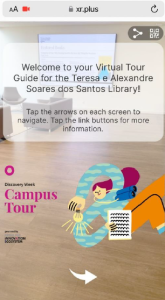
We decided to use AR for the onboarding process of understanding Library services during Discovery Week 2023. To do this, we built our experience around the 3 key pillars of Onboarding Process principles:
Remove friction
AR technology allows students to experience the campus in an immersive and interactive way. Through the AR app we created, students could intuitively view 3D images, Videos and other digital information overlaid onto the physical surroundings. This created a more engaging and memorable tour experience compared to traditional static maps or brochures.
Deliver immediate value
We focused on staying simple and delivering core information such as opening hours, bookings and book loaning process, interspersed with exciting information that we know would drive student attention/engagement – like how to sign up for Buzz services like free magazines and newspapers through Pressreader, how to access free online Bloomberg Certifications etc
Drive future desirable behaviours
Given the number of students using the library services on any given day, we wanted to drive self-exploration of services to drive future self-discovery through app/website rather than just asking questions in-person.
We achieved the above in 2 main ways:
We designed the app experience to align with human behaviour and expectations. By employing gamification principles, we created an intuitive journey that seamlessly integrated virtual information with the physical environment. By understanding the key information students sought, we attempted to answer their questions proactively.
Gamification of physical areas
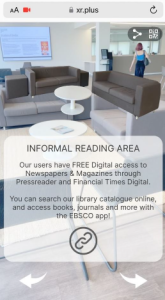
Common questions answered i.e Library Opening Times:
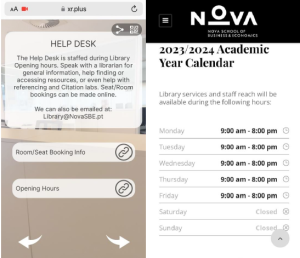
We also made a list of the most common questions that users have and made sure these were answered within the app. For example:
How does the Book Loaning process work?
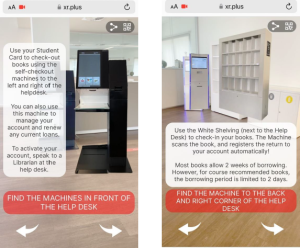
How do I access my Financial Times Subscription?
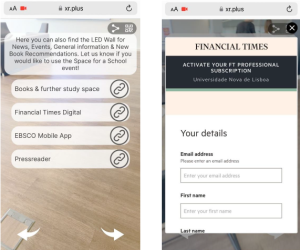
How does Bloomberg work?
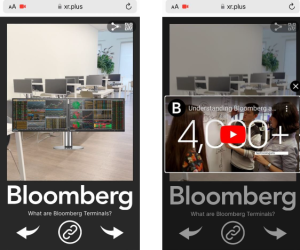
Subsequently, we employed both word-of-mouth marketing and leveraged our in-house LED wall for promotional purposes. This strategic approach not only ensured that our campaign remained eco-conscious by eschewing traditional paper-based methods but also amplified our message effectively.
To gain a holistic understanding of the app’s effectiveness in achieving our goals, we discreetly incorporated a survey at the conclusion of the app experience. While AR technology is undeniably trending, its true impact on our objectives needed empirical validation. We deliberately refrained from verbally disclosing the survey’s presence, which entailed an enticing Gift Card incentive for completion. This approach guaranteed that users engaged with the app in its intended form, primarily to explore and discover more about Library Services, prior to participating in the survey.
Results

Anecdotal feedback and discussion
In sum, the overall response to our AR app was decidedly positive. Prior to its official launch to the student body, we conducted a trial run with three students to assess the usability of the wayfinding feature. Following their initial feedback, which indicated some difficulty in locating a specific area, we swiftly addressed the issue by incorporating a helpful text box hinting at the location. Subsequently, no further comments or concerns were raised regarding wayfinding. This test-run proved to be invaluable in mitigating the potential risk of students becoming disoriented, losing interest, or causing congestion within the environment.
Furthermore, students expressed significant appreciation for the app’s capability to consolidate all essential information into a single platform. They no longer needed to navigate through various webpages or visit multiple websites to access the data they required. Additionally, since the app was web-based, users could conveniently bookmark the URL within their browsers for swift and effortless future access.
Notably, students thoroughly enjoyed the tactile experience the app provided, particularly relishing the gamification element that involved matching virtual screens with corresponding physical areas. As anticipated, the initial flow we designed for the apps user effectively held users’ attention throughout the tour. The decision to confine the experience to a single floor level of the building proved instrumental in managing the flow of foot traffic during the visit, ensuring a seamless and engaging exploration of Library Services.
In-app survey feedback
“Was the best Station so far ” – Masters Student
“No. Good overall information” – Masters Student
“Nothing to add” – Masters Student
Cost-Effective
While creating an initial AR campus tour might require an investment, it can ultimately reduce costs in the long run. Traditional guided tours may involve hiring multiple guides and printing materials, which can add up over time. AR tours can be updated easily and do not require constant reprints or the hiring of additional personnel.
Real-Time Updates
University campuses are dynamic environments with ongoing changes and events. AR platforms allow for real-time updates, ensuring that visitors always have access to the latest information, event schedules, and campus developments.
Gamification
Gamified elements can be integrated into AR tours, making the experience more enjoyable and competitive. Visitors can earn points, badges, or rewards for completing specific challenges or discovering hidden campus gems, increasing engagement and enthusiasm.
Sustainability
Embracing AR tours aligns with sustainability goals by reducing the use of printed materials and minimizing the carbon footprint associated with physical tours. This eco-friendly approach resonates with environmentally conscious prospective students and the broader community. The utilization of Augmented Reality (AR) for the Library Virtual Guide during Discover Week 2023 has demonstrated its potential to revolutionize the onboarding process for students. By integrating AR technology into our approach, we adhered to the principles of simplifying information access, enhancing engagement, and promoting self-exploration. The results were overwhelmingly positive, both anecdotally and through the in-app survey, reflecting the effectiveness of this innovative approach.
The AR app succeeded in removing friction from the traditional onboarding process. It provided an immersive and interactive experience, making it easier for students to grasp key information about Library services while exploring the campus. The gamification elements and the seamless integration of core services with exciting extras captivated students, ensuring that the tour was both informative and enjoyable.
Moreover, the sustainability aspect of the AR approach cannot be overlooked. By reducing the reliance on printed materials and minimizing the carbon footprint associated with physical tours, we aligned our initiative with eco-friendly practices. This resonates not only with environmentally conscious prospective students but also with the broader community.
Looking ahead, there are several future opportunities and considerations that stem from our experience. AR tours have the potential to be cost-effective in the long run, as they eliminate the need for hiring multiple guides and constant reprints of materials. Real-time updates will keep the information fresh and relevant, which is crucial in dynamic university environments. Incorporating more gamified elements can enhance engagement even further, fostering enthusiasm among participants.
In conclusion, the successful implementation of AR for the Library Virtual Guide during Discover Week 2023 underscores the transformative potential of technology in higher education. It represents a step forward in delivering information in an engaging, sustainable, and cost-effective manner, setting a precedent for future innovations in campus tours and onboarding processes.
